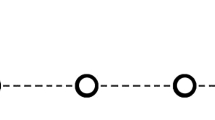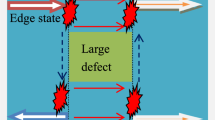Abstract
In the present work, the scattering of the edge-state electrons from two similar two-level atoms located as impurities near the two sites on the zigzag edge of a phosphorene ribbon has been studied theoretically with a focus on the production of entanglement between the impurities. To this end, it is assumed that the electrons are traveling parallel to the zigzag edge of a phosphorene ribbon and the edge states have been used to describe the state of these mobile electrons. Also, it is presumed that the incident electrons interact with the electric dipole of the scatterer atoms. Then, the general scattering theory based on the Lippmann–Schwinger equation has been applied along with the Green function approach to calculate the transition matrix elements and consequently the transmission and reflection probabilities of the mobile electrons. It has been shown that the problem can be reduced to the scattering of electrons along a one-dimensional chain lying along the zigzag edge of the ribbon. We then show that the scattering process leads to creation of a quantum correlation between the similar atomic impurities. Concurrence has been calculated as a measure of the produced entanglement, and its dependence on the energy of the electrons as well as the interaction strengths has been investigated and discussed.





Similar content being viewed by others
Explore related subjects
Discover the latest articles and news from researchers in related subjects, suggested using machine learning.Data availability
The datasets generated and analyzed during the current study are available from the corresponding author on reasonable request.
References
Jaeger, L., Switzerland, B.: The second quantum revolution: from entanglement to quantum computing and other super technolegies. Springer, Switzerland (2018)
Duarte, F.J.: Fundamentals of quantum entanglement. Institute of Physics Publishing, London (2019)
Mishima, M., Hayashib, M., Lin, S.H.: Entanglement in scattering processes. Phys. Lett. A 333, 371 (2004)
Ghanbari-Adivi, E., Soltani, M., Ebtekarnasab, H.: Entanglement generation in scattering of particles from spin impurities. Eur. Phys. J. D 67, 118 (2013)
Amini, M., Soltani, M., Ghanbari-Adivi, E., Sharbafiun, M.: Two-impurity entanglement generation by electron scattering in zigzag phosphorene nanoribbons. Quant. Inf. Process. 18, 78 (2019)
Karlsson, E.B.: Quantum entanglement in low-energy neutron-proton scattering and its possible consequences. Phys. Scr. 95, 025003 (2020)
Kharzeev, D.E., Levin, E.: Deep inelastic scattering as a probe of entanglement: confronting experimental data. Phys. Rev. D 104, L031503 (2021)
Rudolph, H., Hornberger, K., Stickler, B.A.: Entangling levitated nanoparticles by coherent scattering. Phys. Rev. A 101, 011804(R) (2020)
Wallace, P.R.: The band theory of graphite. Phys. Rev. B 71, 622 (1947)
Novoselov, K.S., Geim, A.K., Morozov, S.V., Jiang, D., Zhang, Y., Dubonos, S.V., Grigorieva, I.V., Firsov, A.A.: Electric field effect in atomically thin carbon films. Science 306, 666 (2004)
Meyer, J.C., Geim, A.K., Katsnelson, M.I., Novoselov, K.S., Booth, T.J., Roth, S.: New insight into the graphene based films prepared from carbon fibers. Nature 446, 7131 (2007)
Geim, A.K.: Graphene: status and prospects. Science 324, 1530 (2009)
Li, L., Yu, Y., Ye, G.J., Ge, Q., Ou, X., Wu, H., Feng, D., Chen, X.H., Zhang, Y.: Black phosphorus field-effect transistors. Nat. Nanotechnol. 9, 372 (2014)
Liu, H., Neal, A.T., Zhu, Z., Luo, Z., Xu, X., Tomanek, D., Ye, P.D.: Phosphorene: an unexplored 2D semiconductor with a high hole mobility. ACS Nano 8, 4033 (2014)
Koenig, S.P., Doganov, R.A., Schmidt, H., Neto, A.H.C., Özyilmaz, B.: Electric field effect in ultrathin black phosphorus. Appl. Phys. Lett. 104, 103106 (2014)
Wang, T., Park, M., Yu, Q., Zhang, J., Yang, Y.: Stability and synthesis of 2D metals and alloys: a review. Mater. Today Adv. 8, 100092 (2020)
Rodin, A.S., Carvalho, A., Neto, A.H.C.: Strain-induced gap modification in black phosphorus. Phys. Rev. Lett. 112, 176801 (2014)
Qiao, J., Kong, X., Hu, Z.X., Yang, F., Ji, W.: High-mobility transport anisotropy and linear dichroism in few-layer black phosphorus. Nat. Commun. 5, 4475 (2014)
Li, C., Xie, Z., Chen, Z., Cheng, N., Wang, J., Zhu, G.: Tunable bandgap and optical properties of black phosphorene nanotubes. Materials 11, 304 (2018)
Du, J., Zhang, M., Guo, Z., Chen, J., Zhu, X., Hu, G., Peng, P., Zheng, Z., Zhang, H.: Phosphorene quantum dot saturable absorbers for ultrafast fiber lasers. Sci. Rep. 7, 42357 (2017)
Ezawa, M.: Topological origin of quasi-flat edge band in phosphorene. New J. Phys. 16, 115004 (2014)
Rezaei, M., Karbaschi, H., Amini, M., Soltani, M., Rashedi, G.: Thermoelectric properties of armchair phosphorene nanoribbons in the presence of vacancy-induced impurity band. Nanotechnology 32, 375704 (2021)
Wu, Q., Shen, L., Yang, M., Cai, Y., Huang, Z., Feng, Y.P.: Electronic and transport properties of phosphorene nanoribbons. Phys. Rev. B 92, 035436 (2015)
Maity, A., Singh, A., Sen, P., Kibey, A., Kshirsagar, A., Kanhere, D.G.: Structural, electronic, mechanical, and transport properties of phosphorene nanoribbons: negative differential resistance behavior. Phys. Rev. B 94, 075422 (2016)
Xie, F., Fan, Z.Q., Zhang, X.J., Liu, J.P., Wang, H.Y., Liu, K., Yu, J.H., Long, M.Q.: Tuning of the electronic and transport properties of phosphorene nanoribbons by edge types and edge defects. Org. Electr. 42, 21 (2017)
Amini, M., Soltani, M., Ghanbari-Adivi, E., Sharbafiun, M.: Tunable transmission due to defects in zigzag phosphorene nanoribbons. EPL 125, 67001 (2019)
Amini, M., Soltani, M.: Quantum transport through the edge states of zigzag phosphorene nanoribbons in presence of a single point defect: analytic Green’s function method. J. Phys.: Condens. Matter 31, 215301 (2019)
Li, L.L., Peeters, F.M.: Quantum transport in defective phosphorene nanoribbons: effects of atomic vacancies. Phys. Rev. B 97, 075414 (2018)
Shah, N.A., Li, L.L., Mosallanejad, V., Peeters, F.M., Guo, G.P.: Transport characteristics of multi-terminal pristine and defective phosphorene systems. Nanotechnology 27, 455705 (2019)
Rafie, M., Daeimohammad, M., Soltani, M., Ghanbari-Adivi, E.: Scattering of edge-state electrons from a two-level atom located near the zigzag edge of a phosphorene nanoribbon. Solid. State. Commun. 345, 114687 (2022)
Cai, Y., Ke, Q., Zhang, G., Yakobson, B.I., Zhang, Y.W.: Highly itinerant atomic vacancies in phosphorene. J. Am. Chem. Soc. 138, 10199 (2016)
Hunt, R.J., Szyniszewski, M., Prayogo, G.I., Maezono, R., Drummond, N.D.: Quantum Monte Carlo calculations of energy gaps from first principles. Phys. Rev. B 98, 075122 (2018)
Kheirabadi, N.: Current induced by a tilted magnetic field in phosphorene under terahertz laser radiation. Phys. Rev. B 103, 235429 (2021)
Rudenko, A.N., Katsnelson, M.I.: Quasiparticle band structure and tight-binding model for single- and bilayer black phosphorus. Phys. Rev. B 89, 201408 (2014)
Hanlon, D., Backes, C., Doherty, E., Cucinotta, C.S., Berner, N.C., Boland, C., Lee, K., Harvey, A., Lynch, P., Gholamvand, Z., Zhang, S., Wang, K., Moynihan, G., Pokle, A., Ramasse, Q.M., McEvoy, N., Blau, W.J., Wang, J., Abellan, G., Hauke, F., Hirsch, A., Sanvito, S., O’Regan, D.D., Duesberg, G.S., Nicolosi, V., Coleman, J.N.: Liquid exfoliation of solvent-stabilized few-layer black phosphorus for applications beyond electronics. Nat. Commun. 6, 8563 (2015)
Yasaei, P., Kumar, B., Foroozan, T., Wang, C., Asadi, M., Tuschel, D., Indacochea, J.E., Klie, R.F., Khojin, A.S.: High-quality black phosphorus atomic layers by liquid-phase exfoliation. Adv. Mater. 27, 1887 (2015)
Liu, X.L., Hug, D., Vandersypen, L.M.: Gate-defined graphene double quantum dot and excited state spectroscopy. Nano Lett. 10, 1623 (2010)
Baines, D.Y., Meunier, T., Mailly, D., Wieck, A.D., Bäuerle, C., Saminadayar, L., Cornaglia, P.S., Usaj, G., Balseiro, C.A., Feinberg, D.: Transport through side-coupled double quantum dots: from weak to strong interdot coupling. Phys. Rev. B 85, 195117 (2012)
Yudson, V.I., Reineker, P.: Multiphoton scattering in a one-dimensional waveguide with resonant atoms. Phys. Rev. A 78, 052713 (2008)
Rephaeli, E., Kocabas, S.E., Fan, S.: Few-photon transport in a waveguide coupled to a pair of colocated two-level atoms. Phys. Rev. A 84, 063832 (2011)
Longhi, S.: Quantum decay in a topological continuum. Phys. Rev. A 100, 022123 (2019)
Breuer, H.P., Petruccione, F.: The theory of open quantum systems. Oxford University Press, London (2007)
Banerjee, S.: Open quantum systems: dynamics of nonclassical evolution. Springer, Singapore (2018)
Amini, M., Soltani, M., Sharbafiun, M.: Vacancy-induced Fano resonances in zigzag phosphorene nanoribbons. Phys. Rev. B. 99, 085403 (2019)
Ahmadi, I., Soltani, M., Rashedi, G.: Analytical calculation of scattering from spin impurity and entanglement generation for edge states of Kane-Mele model. Physica E 139, 115127 (2022)
Ghanbari-Adivi, E., Soltani, M., Sheikhali, M.: Entanglement generation due to the Klein tunneling in a graphene sheet. Quant. Inf. Process. 15, 2377 (2016)
Author information
Authors and Affiliations
Corresponding author
Additional information
Publisher's Note
Springer Nature remains neutral with regard to jurisdictional claims in published maps and institutional affiliations.
Rights and permissions
Springer Nature or its licensor (e.g. a society or other partner) holds exclusive rights to this article under a publishing agreement with the author(s) or other rightsholder(s); author self-archiving of the accepted manuscript version of this article is solely governed by the terms of such publishing agreement and applicable law.
About this article
Cite this article
Hosseinnakhaei, M., Soltani, M., Daeimohammad, M. et al. Electron-scattering-induced entanglement between two atoms placed near the zigzag edge of a phosphorene ribbon. Quantum Inf Process 22, 32 (2023). https://doi.org/10.1007/s11128-022-03785-2
Received:
Accepted:
Published:
DOI: https://doi.org/10.1007/s11128-022-03785-2




